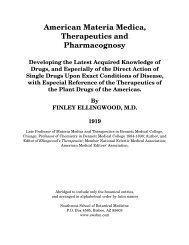SCARLET FEVER. Synonyms.—Scarlatina; Scarlet Rash. Definition ...
SCARLET FEVER. Synonyms.—Scarlatina; Scarlet Rash. Definition ...
SCARLET FEVER. Synonyms.—Scarlatina; Scarlet Rash. Definition ...
You also want an ePaper? Increase the reach of your titles
YUMPU automatically turns print PDFs into web optimized ePapers that Google loves.
alarming condition early in the disease, but as the case advances it<br />
disappears entirely; while another class of patients will “spit blood” more<br />
or less frequently during the entire progress of the disease.<br />
In the early stages the hemorrhage is rarely ever profuse and never<br />
dangerous, while those occurring in the advanced stage may prove<br />
fatal, though this is very rare. The blood is usually bright red and<br />
frothy, characteristic of hemoptysis. The mucus may be simply streaked<br />
or tinged with blood, or it may be decidedly rusty. Hemorrhage most<br />
frequently occurs after mental excitement, or physical exertion, or<br />
paroxysm of coughing, though sometimes it occurs without any<br />
apparent cause. Thus, in one of my patients, the hemorrhage invariably<br />
occurred in the night, he being awakened by a choking sensation,<br />
which was due to the pressure of the blood.<br />
In the milder forms it follows the cough, while at other times it seems to<br />
flow to the upper part of the larynx and into the pharynx, and is simply<br />
spit out. The hemorrhage is due, in the early stages, to hyperemia, and<br />
the blood exudes from the feeble vessels, most likely, due to pressure<br />
from tubercular deposits. After cavity formation, there may be erosion of<br />
a larger vessel, when the hemorrhage becomes alarming and very<br />
rarely fatal. In a practice of twenty-five years I have met with but one<br />
fatal hemorrhage in this disease; this in a child ten years old, who died<br />
in five minutes after the rupture of the blood-vessel.<br />
Hemorrhage from the lungs, while not necessarily an evidence of<br />
tuberculosis, should always be regarded with grave suspicion, and cause<br />
careful and repeated examinations on the part of the physician.<br />
Dyspnea.—In the early stage of the disease there is little suffering from<br />
“shortness of breath,” unless preceded by active exertion. In the later<br />
stages, however, it often proves one of the most distressing conditions.<br />
General Symptoms.—Fever.—One of the earliest symptoms, even<br />
before the cough, is an elevation of temperature, and if it remains<br />
constant for days, with a progressive decline in health, it is one of the<br />
most reliable evidences of the dread disease. The first evidence of the<br />
toxin in the blood is to produce fever, which varies in character. In one<br />
it will be of the continued type, while in another it will be remittent or<br />
intermittent in character, or again partake of both, being decidedly<br />
irregular. In fact, the irregular character of the fever in tuberculosis is<br />
one of its characteristics.<br />
The Eclectic Practice of Medicine - PART I - Infectious Diseases - Page 199

















